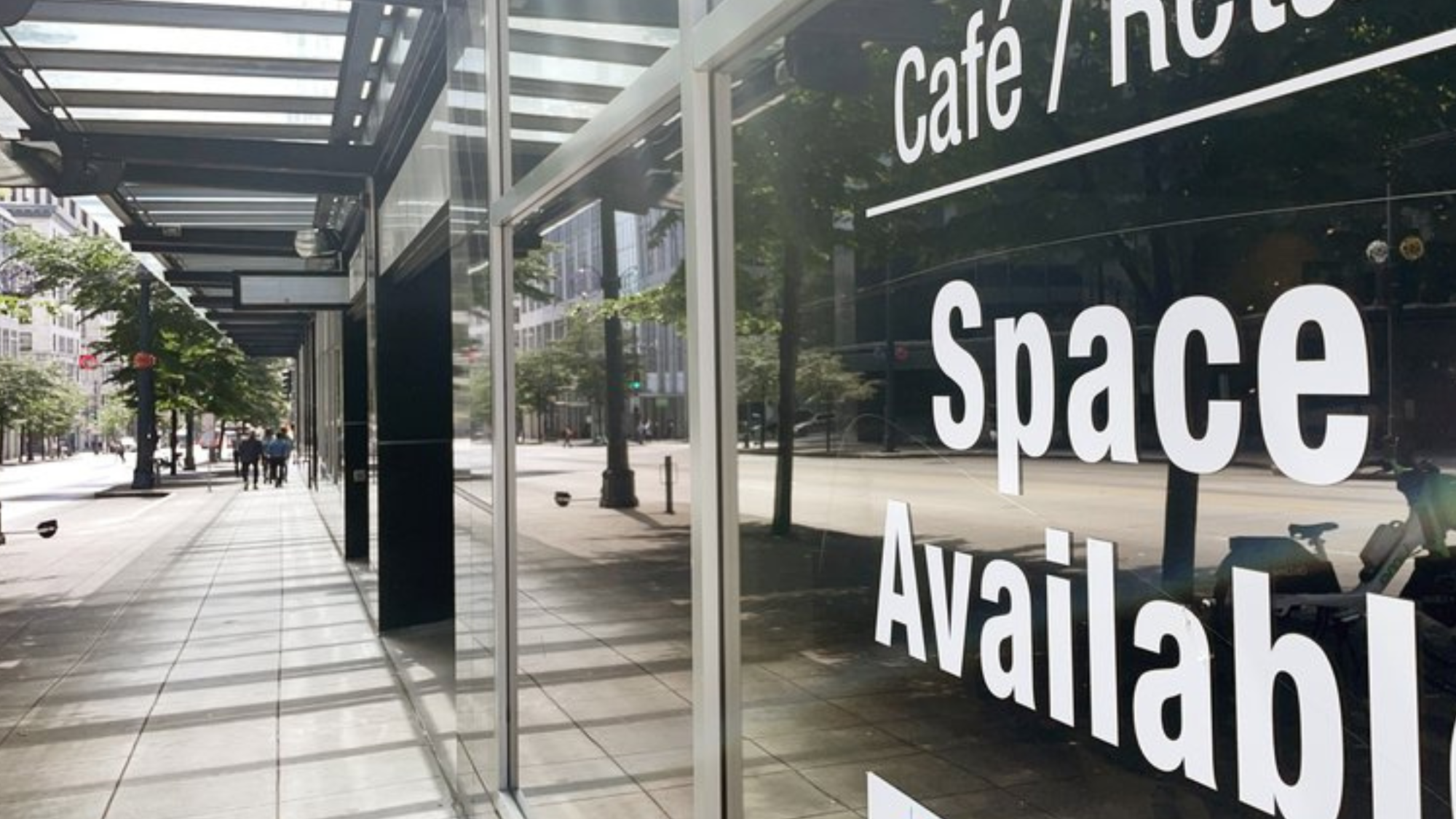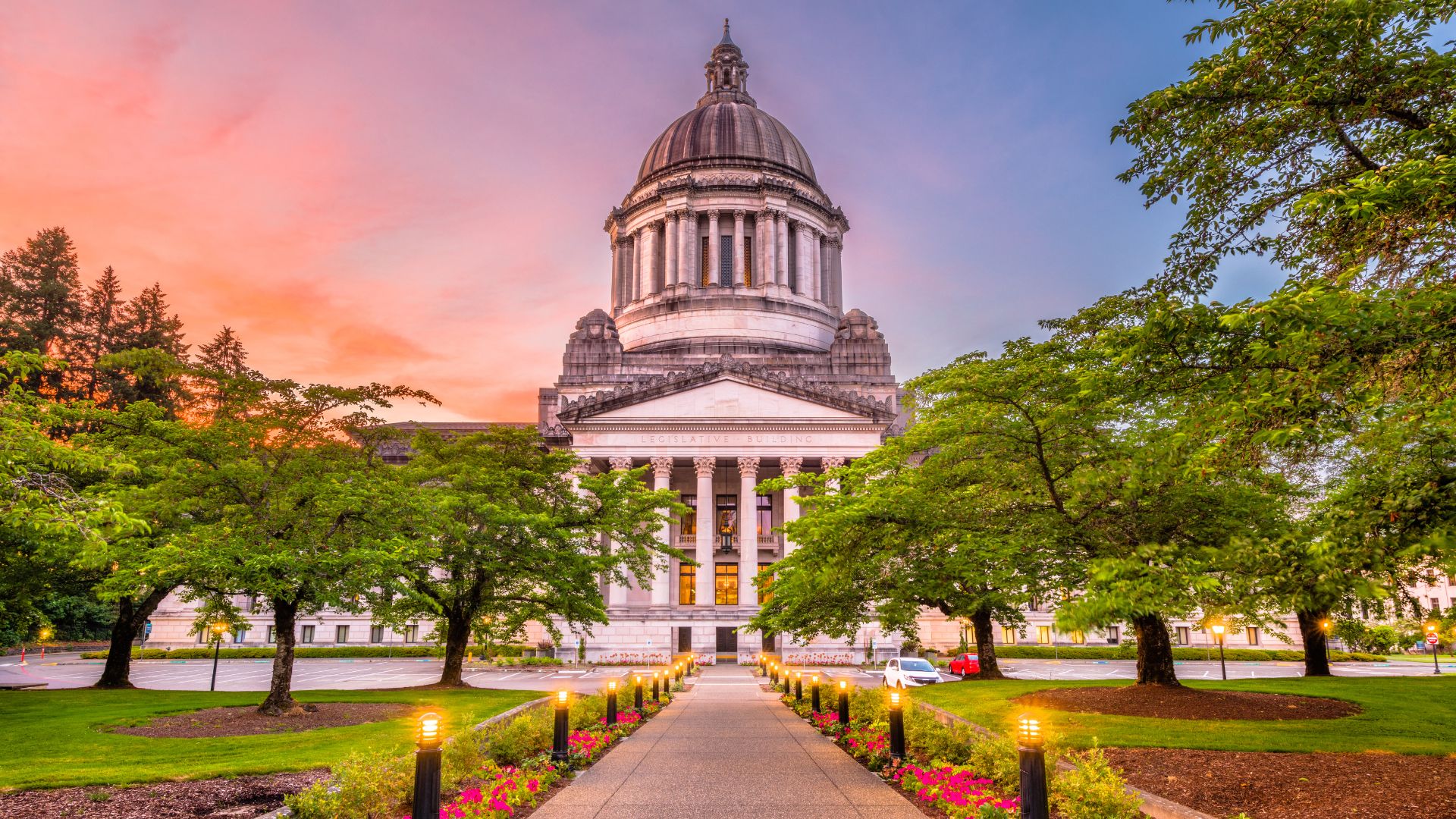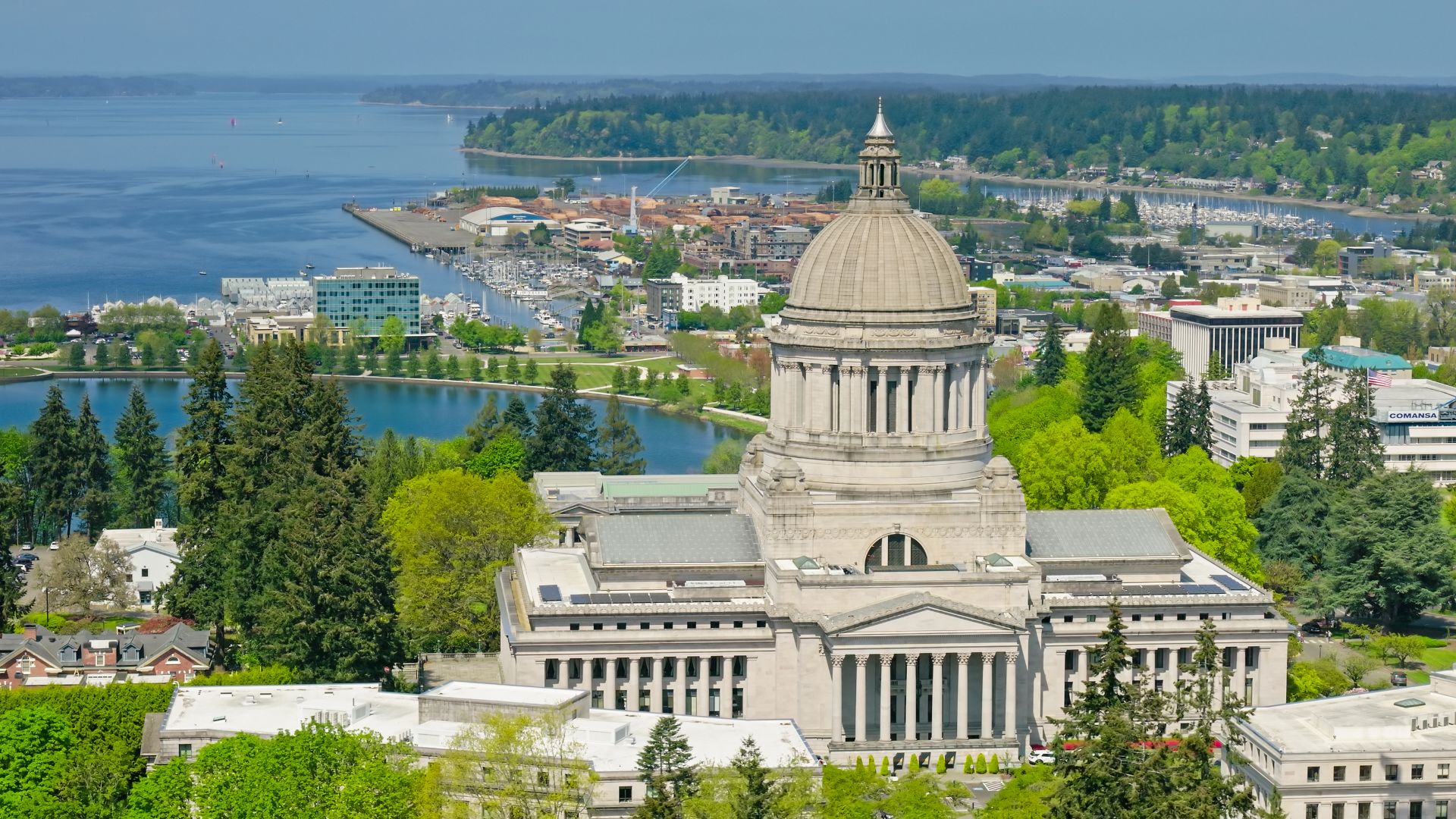The former Specialites retail space at 1023 3rd Ave. sat vacant in July as downtown retailers contended with theft averaging around 10-12% loss in goods each year for a store. Anthony Bolante | PSBJ
By Joey Thompson – Reporter, Puget Sound Business Journal Dec 23, 2024
Theft has driven some retailers out of Seattle, but that’s not the only challenge for downtown storefronts.
Sitting inside Century Square’s nearly empty lobby on a Tuesday, Olga Sagan knows she’s in a tough spot. The Piroshky Piroshky owner doesn’t plan on renewing her lease at the base of the office building on Third Avenue and Pike Street.
Sagan, a one-time Seattle City Council candidate, is one of downtown’s most outspoken small business owners. She also has one of the clearest views of how foot traffic has changed since the onset of the pandemic, with locations at Pike Place Market, Third and Pike and the Columbia Center.
At Third and Pike, sales are down 70% from 2019 and more than 5% from 2023. On occasion, daily sales can be as low as $200 – a reality of operating a business in the most avoided area of downtown, across the street from a group of boarded-up retail spaces.
“Each one of those little storefronts used to be a business, right?” Sagan said in August. “It was a burger place and a Starbucks. I would love to have three or four stores open somewhere around here. But then again, people do not want to come here. People are avoiding this area. So, it’s hard to put storefronts in places people are avoiding.”
Just five years prior, the walk-up window outside Piroshky Piroshky’s newly opened location drew long lines. So did the counter inside the building.
Today, a line seldom forms at either register. Century Square’s office space is about 20% occupied, Sagan said, and the intersection of Third and Pike has become the focal point of a regionwide conversation about crime, addiction and homelessness since the onset of the pandemic shuttered offices and shut down travel and tourism.
From downtown advocacy groups to real estate brokers, to restaurant owners and salad chain CEOs, observers all say Seattle’s downtown recovery is happening block by block. That process has seen a slew of national retailers leave the area, including Nike, the North Face, Lululemon, Saks OFF Fifth, Carhartt and Vans. It’s a trend that shows little sign of stopping, as office worker volumes and local foot traffic in the central business district trend positive in fits and starts.
For the areas lagging behind, retail theft, public drug use and perceptions of public safety are among the top obstacles cited by downtown advocates to filling major vacancies and keeping existing retailers from closing up shop.
Maria Royer said it starts with Third and Pike. As principal of Real Retail, Royer represents some of the highest-profile spaces in and around Seattle. That includes several marquee locations along the Pike and Pine corridor, once considered the best retail area in the city.
“We have to address these pockets. It’s absurd,” she said in July. “If you go to Rainier Square Tower and the Metropolitan Tract, where we’ve had significant leasing activity, it’s night and day. When we have (prospective tenants) that come in from out of town, we say we still have a lot to do, leadership is working on ways to address these issues and we’ve made progress. But there’s a lot more progress to be made, probably slower than the rest of us want it to be.”
Retailers bulk up security measures
Downtown Seattle’s Pacific Place mall – a major piece of the city’s urban renewal efforts – sits more than half empty.
The mall traded hands earlier this year for a fraction of its previous value, as it has largely failed to hold onto its retail tenants. Lululemon became the latest major retailer to depart earlier this year.
Representatives for the activewear and yoga brand did not disclose why the store closed. Royer, of Real Retail, said tenants like Lululemon, Nike and The North Face, all of which also closed their downtown Seattle locations in recent years, are targets for organized retail theft, “because of the resale value of their merchandise.”
Such theft has become a $2.7 billion problem annually for the state’s retailers, per the Washington Retail Association. That can average out to a 10%-12% loss in goods each year for a store.
Before the pandemic, the average loss was anywhere from 2%-4%, Mark Johnson, who leads policy and government affairs for the group, told the Business Journal in August. He attributed the uptick in theft – which has affected retailers across the state, not solely in downtown Seattle – to changes to police pursuit rules passed by lawmakers in 2021.
“This is not shoplifting,” Johnson said. “This is not a crime of opportunity, where nobody’s looking. This is not a crime to feed yourself. These are planned, premeditated and intentional. It is so much easier to steal from a retail establishment, not be held accountable, not serve real time, than it is to steal from a bank. These criminal rings know that, and that’s why they’re hitting our stores.”
For Nordstrom, King County has become the luxury department store’s worst area for retail crime in the country, CEO Erik Nordstrom told a room of law enforcement officials, prosecutors and other government leaders this fall at Microsoft’s Redmond campus. King County stores make up about 3% of the company’s global footprint and account for 10% of its companywide losses due to theft, he said.
The meeting in Redmond was organized by Challenge Seattle, the civic-minded coalition of private companies in the area led by former Gov. Chris Gregoire, in addition to the Washington Retail Association, Seattle Metropolitan Chamber of Commerce, Bellevue Chamber and Sound Cities Association. It aimed to highlight ways to bring law enforcement, retailers and prosecutors together to better tackle organized retail crime. That includes a pilot program with King County and city of Seattle prosecuting attorneys, more than 10 local police departments and brands like Nordstrom, REI, Target, Macy’s, Lululemon, Best Buy and Home Depot.
Those efforts are showing early returns.
Earlier this year, police in Bellevue arrested four women who allegedly stole more than $500,000 worth of merchandise from dozens of stores across Western Washington and the Portland area, including Lululemon and Nordstrom. The person who is alleged to have fenced the goods was also arrested a few months later.
Some retailers have responded to theft by hiring security or additional staff to monitor stores, another stressor on operating margins. For Piroshky Piroshky’s Kent restaurant, Sagan pays $7,000 a month for security.
Customers are scarce in downtown
When the outdoor brand Himali chose Fourth and Pike for its first Washington store, its founder said he wanted the company to become “an integral part of the ‘new’ downtown.”
Himali moved into the space formerly occupied by Arc’teryx, which moved across the street into a larger storefront. It was the kind of news cited by local leaders and industry officials to signal downtown’s retail recovery was gaining momentum.
Six months later, Himali abruptly closed the store, citing issues with operating downtown – another sign that the retail core still struggles to produce enough foot traffic to keep businesses open.
For restaurants, office worker traffic is a three-day-a-week business, former Evergreens CEO Ian Courtnage told the Business Journal this summer.
“Where you’ve got some critical mass of office workers, it gets easier,” he said. “That all sets up well for our model, not nearly as well as pre-Covid. But if you’re dependent on evenings, that’s a problem.”
Even Pike Place Market, which many regard to be the area of downtown that has recovered the fastest, has yet to see visits from locals rebound to 2019 levels. Bringing those customers back is a key piece of the market’s newly adopted master plan.
Sagan’s Pike Place Market location continues to perform well. So does her Columbia Center restaurant, though she attributes its success to the lack of competition in the area.
While local discussions of Seattle may skew toward a gloomy outlook on downtown, outsiders, such as national brand reps touring the city, appear to have a higher opinion of the area, Royer said.
“We have people that come in from all over the world that travel to Seattle, and they’re like, ‘Wow, this is way better’ than what the press tells them,” Royer said. “They’re coming from New York, San Francisco and Chicago, so they see it themselves and they understand that these big cities have their issues. They’re very interested to know what our leadership is doing, and who our leadership is and what’s happening with our city council.”
City courts retailers
On a clear winter morning in November, a crowd formed at First and Pike.
They were gathered to hear Mayor Bruce Harrell tout the progress of his downtown activation plan – a multifaceted approach to fighting the fentanyl epidemic, addressing homelessness and activating empty storefronts. It’s same intersection where Starbucks abruptly closed one of its busiest coffee shops in the city. A few doors down, the Hard Rock Cafe closed its longtime restaurant earlier in the year.
For Starbucks, it was the latest in a growing number of local closures. In some cases, the Seattle coffee giant cited concerns about safety. In others, no explanation was given.
At City Hall, sitting in the Norm B. Rice room, Harrell said he’s met with Starbucks brass, including former CEO Howard Schultz, as well as the Nordstrom brothers, Pacific Place’s new owners and other retail leaders, to ask what the city can do to help.
“It starts with them knowing I want them here unambiguously,” Harrell said. “I want you to know your nearest precinct. I want you to know our police officers. I want our officers trying to get out of their cars to the extent they can and do visits and make their presence known.”
At the same time, Harrell said, retailers like Starbucks and Nordstrom must adapt to shifts in the industry. If one coffee shop closes, he said, perhaps another could perform better in the space.
“One of the beautiful things about downtown is that it’s not static, it’s dynamic,” he said. “As much as I want retailers here, there is going to be change.”
Assisting in that change is a large piece of Harrell’s downtown activation plan, which connects building owners with small businesses and artists to quickly fill retail spaces.
Brokers and landlords have also found another solution to activate large vacant spaces – short-term interactive attractions, like the Titanic exhibit on the waterfront at the Maritime Building. Others have popped up for shows like “Friends,” “Stranger Things” and “The Office.”
“It’s proof of concept,” Royer said. “If you can say the Museum of Illusions opened and they’re tracking 100,000 people a month, that just shows tenants that want to come to Seattle, you can be successful, and look how successful these tenants have been.”
On Third and Pike, the street corner has improved in the last few months, Sagan told the Business Journal in December. She credited work by the city and Downtown Seattle Association for the change.
However, she hasn’t gained much optimism for her Century Square location.
Much of the disruption and drug use hasn’t gone away, she said – it’s just moved toward the vacant Starbucks at First and Pike. And while her Tuesday through Thursday business is up 10% in recent months, it’s still “way below” 2019 levels.


